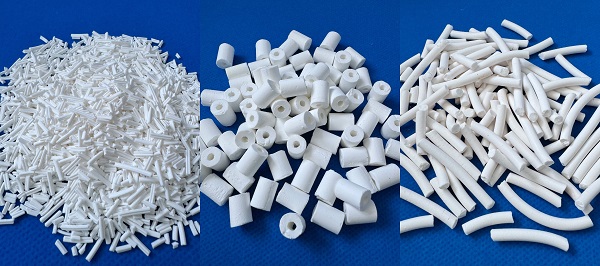一. Why is alumina the preferred catalyst support?
1. High Surface Area: Alumina (especially the γ-type) offers a surface area of up to hundreds of square meters per gram, providing a vast dispersion platform for active metal components, maximizing exposure of active sites and improving atomic utilization efficiency.
2. Adjustable Surface Acidity: Alumina surfaces possess Lewis and Brönsted acid sites, adapting to the needs of different reactions.
3. Excellent Thermal Stability and Mechanical Strength: Alumina supports can withstand high reaction temperatures and maintain structural stability through multiple regeneration cycles. Its excellent mechanical strength prevents catalyst wear and pulverization during loading, use, and regeneration, extending the operating life of industrial equipment.
4. Rich Porosity: By controlling the preparation process, the pore size distribution and pore volume of alumina can be precisely controlled, from micropores to mesopores, to meet the mass transfer requirements of reactants of varying molecular sizes.
5. Excellent Cost-Effectiveness: A wide range of raw material sources and mature preparation processes enable alumina supports to offer excellent performance at a relatively low cost.
二、 Crystal form and selection of alumina
The diversity of alumina is primarily reflected in its crystal forms. Different crystal forms are stable at different temperatures and have distinct properties.
Crystal form | Stable temperature range | Key Features | Application Scenario |
γ-Al₂O₃ | Medium to low temperature (500-750°C) | High specific surface area, abundant mesopores, and acidic surface. | The most commonly used catalyst carrier, widely used in hydrotreating, automobile exhaust purification, dehydration reaction, etc. |
η-Al₂O₃ | Medium to low temperature | Similar to the γ type, but with slightly different surface acidity and structure. | Commonly used in reforming catalysts. |
θ-Al₂O₃ | Medium to high temperature | It is transformed from the γ/η phase and is a transition phase to the α phase. | Used in certain situations where higher temperature stability is required. |
α-Al₂O₃ | high temperature(>1200°C) | Low specific surface area, extremely high thermal stability and mechanical strength, chemically inert. | Suitable for extremely high temperature reactions |
三.How to choose the right alumina support for your process?
Choosing the right alumina support isn't as simple as "just use γ." You need to thoroughly discuss the following technical parameters with your supplier:
1. Specific Surface Area: Do the reactants have high molecular weights or do you need highly dispersed active components? Choose a high specific surface area. Do you need high-temperature stability?
2. Pore Size and Pore Volume:
For large molecule reactions (such as heavy oil hydrogenation), a support with large pores (>10 nm) or even macroporous pores is required to avoid diffusion limitations.
For small molecule reactions, a mesoporous support (2-50 nm) is generally the best choice.
3. Surface Acidity: Does your reaction require acidic sites to promote it, or does it require a neutral surface to avoid side reactions? This determines whether and how surface modification is necessary.
4. Shape and Size: Industrial catalysts require specific shapes (spheres, strips, cloverleafs, honeycombs) to control pressure drop and mass transfer efficiency in the reactor.
5. Purity and Impurities: Certain impurities (such as Na₂O) can poison the active sites, so the support purity must be controlled based on the reaction requirements.
Looking for the best alumina catalyst support for your process? Contact our technical experts today for free samples and customized solutions. We offer a comprehensive range of products, from gamma to alpha, from standard to customized pore sizes and acidity, to meet your most demanding catalytic needs.













